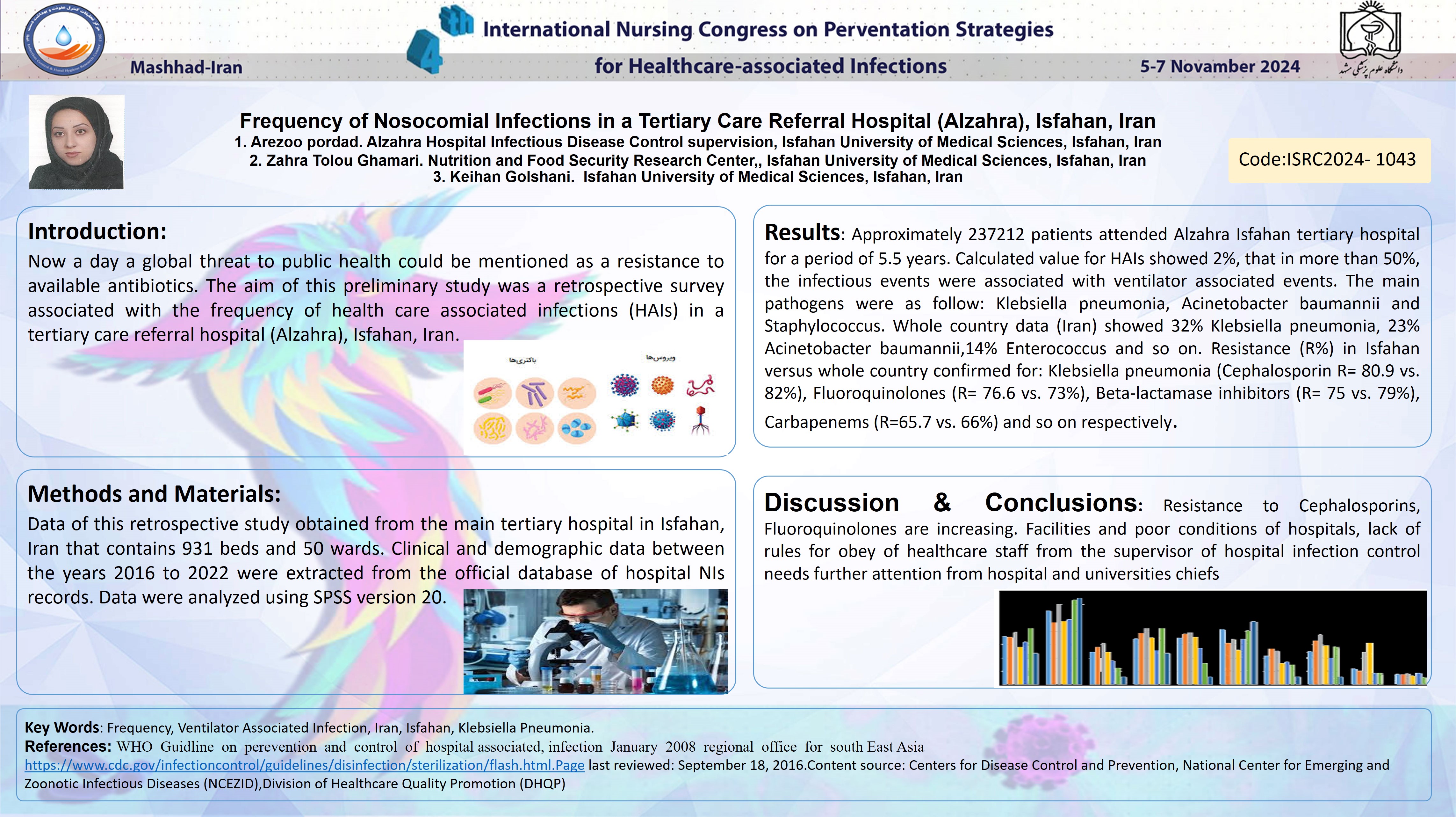فراوانی عفونت های بیمارستانی در بیمارستان فوق تخصصی الزهرا(س) اصفهان-سطح سوم ارجاع
کد: G-1043
نویسندگان: Arezoo Pordad © ℗, , Zahra Tolou Ghamari , Keihan Golshani
زمان بندی: زمان بندی نشده!
دانلود: دانلود پوستر
خلاصه مقاله:
خلاصه مقاله
Frequency of Nosocomial Infections in a Tertiary Care Referral Hospital (Alzahra), Isfahan, Iran Arezoo Pourdad1, Zahra Tolou_Ghamari 2Keihan Golshani 3 1Alzahra Hospital Infectious Disease Control Unit, Isfahan University of Medical Sciences, Isfahan, Iran 2Nutrition and Food Security Research Center, Deputy of Research and Technology, Isfahan University of Medical Sciences, Isfahan, Iran 3 Isfahan University of Medical Sciences, Isfahan, Iran Running Title: Hand Hygiene & HAIs *Address for correspondence: Arezoo Pourdad: Supervisor Alzahra Hospital Infectious Disease Unit, Isfahan University of Medical Sciences, Isfahan, Iran. E mail address. arezoo_pordad@yahoo.com Abstract Background: Now a day a global threat to public health could be mentioned as a resistance to available antibiotics. The aim of this preliminary study was a retrospective survey associated with the frequency of health care associated infections (HAIs) in a tertiary care referral hospital (Alzahra), Isfahan, Iran. Methods: Data of this retrospective study obtained from the main tertiary hospital in Isfahan, Iran that contains 931 beds and 50 wards. Clinical and demographic data between the years 2016 to 2022 were extracted from the official database of hospital NIs records. Data were analyzed using SPSS version 20. Results: Approximately 237212 patients attended Alzahra Isfahan tertiary hospital for a period of 5.5 years. Calculated value for HAIs showed 2%, that in more than 50%, the infectious events were associated with ventilator associated events. The main pathogens were as follow: Klebsiella pneumonia, Acinetobacter baumannii and Staphylococcus. Whole country data (Iran) showed 32% Klebsiella pneumonia, 23% Acinetobacter baumannii,14% Enterococcus and so on. Resistance (R%) in Isfahan versus whole country confirmed for: Klebsiella pneumonia (Cephalosporin R= 80.9 vs. 82%), Fluoroquinolones (R= 76.6 vs. 73%), Beta-lactamase inhibitors (R= 75 vs. 79%), Carbapenems (R=65.7 vs. 66%) and so on respectively. Conclusion: Resistance to Cephalosporins, Fluoroquinolones are increasing. Facilities and poor conditions of hospitals, lack of rules for obey of healthcare staff from the supervisor of hospital infection control needs further attention from hospital and universities chiefs.
کلمات کلیدی
Key Words: Frequency, Ventilator Associated Infection, Iran, Isfahan, Alzahra, Klebsiella Pneumonia.
